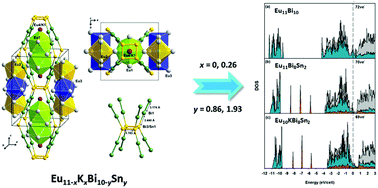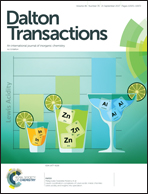Single and double-doping effects on the thermoelectric properties of two Zintl compounds: Eu11Bi8.07(2)Sn1.93 and Eu10.74(2)K0.26Bi9.14(2)Sn0.86†
Abstract
Two Zintl phase thermoelectric compounds of Eu11−xKxBi10−ySny (x = 0, 0.26(1); y = 0.86(2), 1.93(2)) have been synthesized by a high-temperature solid-state reaction and arc-melting methods. The two isotypic crystal structures are characterized by both single-crystal and powder X-ray diffractions, and adopt a tetragonal Ho11Ge10-type structure (space group I4/mmm, Z = 2, Pearson code tI84) containing nine crystallographically independent asymmetric atomic sites in a unit cell. The chemical compositions are confirmed by EDS analysis. The complex crystal structure of the two title compounds can be described as an assembly of three different types of co-facial polyhedra formed by cations and 3-dimensional anionic frameworks surrounding these polyhedra. A quaternary title compound, Eu10.74(2)K0.26Bi9.14(2)Sn10.86, which simultaneously contains both cationic and anionic p-dopants in a single compound, was successfully crystallized for the first time in the A11M10 (A = alkaline-earth metals, rare-earth metals; M = triels, tetrels, pnictogens) series. In particular, two different types of p-dopants K and Sn show particular site-preferences, respectively, where K and Sn prefer to occupy the cationic Wyckoff 4e site and the anionic Wyckoff 8h site. These noticeable site preferences can be elucidated by either a size-factor criterion for the K-doping case or by an electronic-factor criterion for the Sn-doping case. The tight-binding linear muffin–tin orbital calculations show that as the double p-doping is applied to the Eu11−xKxBi10−ySny system, some extra holes are generated on the electronic structures according to the density of states curves. However, a series of thermoelectric property measurements prove that this extra hole-carrier doping is hardly effective enough to completely suppress a bipolar conduction of holes and electrons due to the rigid metallic band structure of the title system.



 Please wait while we load your content...
Please wait while we load your content...